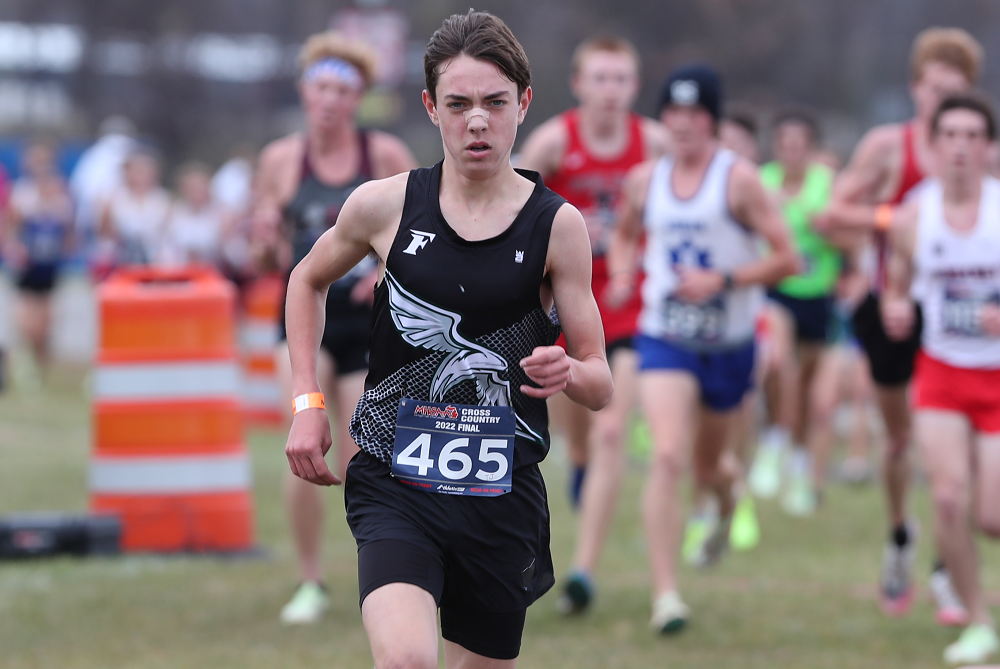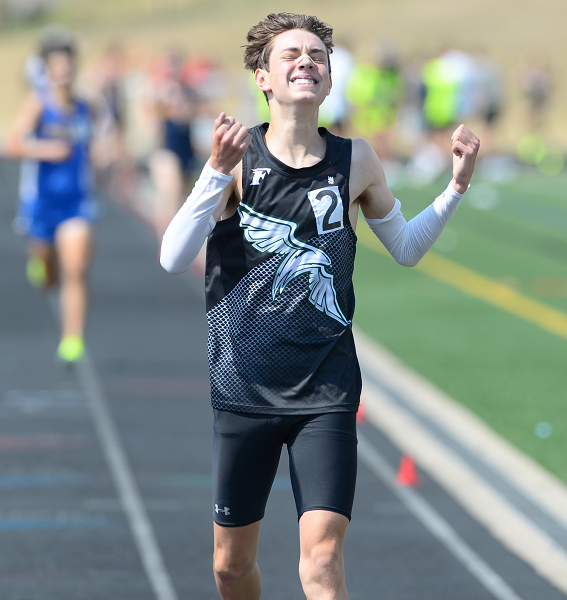
D2 Champs Turn in Elite Performances
November 7, 2015
By Bill Khan
Special for Second Half
BROOKLYN — It finished as expected, with a duel between Algonac senior Morgan Beadlescomb and Corunna junior Noah Jacobs.
 However, the two fastest runners in the state this season had company for longer than anticipated during the MHSAA Lower Peninsula Division 2 meet Saturday at Michigan International Speedway.
However, the two fastest runners in the state this season had company for longer than anticipated during the MHSAA Lower Peninsula Division 2 meet Saturday at Michigan International Speedway.
A pack of four runners entered the stadium with about 1,200 meters remaining, with Pontiac Notre Dame teammates Brendan Fraser and Nathan Mylenek intent on crashing the party.
With the finish line in sight on the long straight away, the two favorites separated from Fraser and Mylenek and launched a battle for the championship. Beadlescomb prevailed to repeat as Division 2 champion with a time of 15:26.5. Jacobs was second in 15:30.5, with Fraser taking third in 15:39.4 and Mylenek fourth in15:40.5.
Even at the highly competitive Portage Invitational on Oct. 10, Beadlescomb and Jacobs cleared the field by the mile mark and raced to the two fastest times in Michigan this season. Beadlescomb edged Jacobs by one second that day with a time of 14:59.
The difference this time was the wind, into which nobody was willing to push the pace alone up front.
"This race was completely different," Beadlescomb said. "I knew it was going to be a kicking race before the first mile. Something inside me was just saying, 'Go,' but I had to stay because people behind me will just use me and that will waste energy."
"Neither of us likes to take the lead and eat the wind," Jacobs said. "I figured somebody would take it for us, which happened."
The race featured the winners of the two distance events at last spring's Lower Peninsula Division 2 Track and Field Finals. Beadlescomb won the 1,600-meter run in 4:13.58, while Jacobs took the 3,200 in 9:27.49. Jacobs didn't run the 1,600, while a fatigued Beadlescomb was fifth in the 3,200.
They met twice during the regular season, with Jacobs finishing nine seconds ahead of Beadlescomb in the Spartan Elite race at the Spartan Invitational on Sept. 18 before Beadlescomb won Portage.
"He's a great kid," Beadlescomb said of his rival. "We wish each other luck every time we see each other. It's good competition. We're hard and we push each other, but it's good. It really helps both of us. I can't wait to see what he does next year as a senior."
 While disappointed over finishing second, Jacobs would prefer a race like Saturday's to any of the easy victories a runner of his caliber routinely racks up during a season.
While disappointed over finishing second, Jacobs would prefer a race like Saturday's to any of the easy victories a runner of his caliber routinely racks up during a season.
"It's a lot more fun to go out there and have great competition and really do something special than if you win your conference by 30 seconds or something like that," said Jacobs, who was fifth in the Final last year. "It's special to go out and see your training pay off in a big-time situation like that. I wanted to win today. I'm handling this well right now, but deep down I'm pretty hurt. I wanted to come out and win today. Morgan's a great competitor. I knew it would be a tough race. He outraced me."
The battle for the team championship wasn't nearly as close, as Fremont rolled to a 69-162 victory over runner-up Otsego.
Fremont had four runners in the top 19, led by fifth-place junior Matthew Zerfas in 15:44.7. Zerfas was fourth last year.
Also scoring for Fremont were junior Sam Kaastra (14th, 16:05.7), junior Cole Hamilton (16th, 16:07.9), sophomore Ben Schmidt (19th, 16:11.8) and junior Sam Stitt (35th, 16:26.5).
Ranked No. 9 coming into the meet, Otsego's boys were the lowest-ranked team to take home a championship or runner-up trophy in any division Saturday. Only 12 points separated second-place Otsego from fifth-place Corunna.
Alex Comerford led Otsego, taking 13th in 16:04.5 to finish first among freshmen. It was Otsego's best finish at an MHSAA Finals meet, eclipsing third-place finishes in 1951, 1961, 1962 and 2008.
Third-place Clio (171 points) had the best finish in school history, improving on fourth-place showings in 1963 and last year. It was the first time since 1963 and 1964 that the Mustangs have made the top 10 in back-to-back years.
The MHSAA Cross Country Finals are sponsored by the Michigan National Guard.
PHOTOS: (Top) Algonac’s Morgan Beadlescomb (446) and Corunna’s Noah Jacobs (294) stayed with the lead pack early before breaking away near the end of the Division 2 Final. (Middle) Fremont’s Cole Hamilton (322) works to stay ahead of the Clio’s Ethan Taljonick. (Click for more from RunMichigan.com.)

Freeland's Hansen Not Focused on Joining All-Time Greats - But On His Way
By
Paul Costanzo
Special for MHSAA.com
September 29, 2023
The goal written on Matt Kaczor’s Post-It Note was sub-15 minutes, 15 seconds. That’s what the Freeland cross country coach was hoping for from star runner TJ Hansen during his junior season.
 Kaczor tore it up after seeing Hansen run a single race this fall.
Kaczor tore it up after seeing Hansen run a single race this fall.
“Knowing what he did over the summer and where he was at, seeing what his 1,600 (meter) and his mile got down to, I had a feeling he could get under 15:30 quickly,” Kaczor said. “After the first race, I looked at my assistant and was like, ‘I’ve gotta rip up that Post-It Note. I don’t think our goal is on the level of where he’s at right now.’ At first, it was break 15:15. Once I saw him race at the Under the Lights (on Aug. 18 at St. Johns), I was like, ‘Yeah, he’s going sub 15.’”
Hansen ran 15:39.6 in that first race, and on Sept. 7, in Shepherd, he ran 15:13.9 to meet the goal written on the now-shredded Post-It Note.
This past Saturday, he ran 15:03.7 at the Cadillac Veterans Serving Veterans Invitational. It’s the fastest time recorded in Michigan this year, and a signal that Kaczor might be filling out a new Post-It Note before the season is out.
“The sub-15 barrier, that’s been something on my mind for a while,” Hansen said. “Now that I’m edging closer and closer to that, it’s been exciting. With how heavy my training has been, I wouldn’t expect (to have run this fast this early). Being able to run the times I am really paints the picture for what’s ahead.”
Hansen came into the season already regarded as one of the elite distance runners in the state. He won the 3,200 meters at the MHSAA Lower Peninsula Division 2 Track & Field Finals this past spring. He’s also finished all-state (12th and fifth, respectively) the past two seasons at the LPD2 Cross Country Finals.
His current trajectory, however, would put his name near some of the state’s all-time greats. But that’s not something Hansen is focusing on.
“I really don’t like to compare myself to others,” he said. “I don’t focus on that. I try to be the best TJ Hansen that I can be. The best version of myself.”
Focusing on himself is almost necessary for Hansen, as he’s spending a lot of time during his races running by himself.
At each of the big events Freeland has run in this season, Hansen has finished at least 20 seconds ahead of his nearest competitor. That includes all divisions of the Duane Raffin Festival of Races in Holly.
In Cadillac, where Hansen ran his current best time, he was a full minute ahead of the rest of the field.
 “He’s just a special athlete,” Kaczor said. “I can’t see Freeland having someone like this in a while. He’s a generational talent. What’s crazy is, I had the school record when he was a freshman. He and Braden (Honsinger) broke it last year. But TJ has now dropped that school record (set in 1998) by almost a minute.”
“He’s just a special athlete,” Kaczor said. “I can’t see Freeland having someone like this in a while. He’s a generational talent. What’s crazy is, I had the school record when he was a freshman. He and Braden (Honsinger) broke it last year. But TJ has now dropped that school record (set in 1998) by almost a minute.”
Hansen’s achievements have already put him on a path to run at the next level, which is something of a family tradition.
His older sisters Peyton and Kiera are track & field athletes at Wayne State and Eastern Michigan, respectively. Their parents, Tim and Pam, were track & field stars at Central Michigan.
TJ has drawn the attention of coaches around the country, including from Michigan, Michigan State, Wisconsin, Tennessee and Colorado.
Having family members who know the process is a help for Hansen, and he said they’ve all been good about allowing him to choose his own path, whatever that may be.
“He’s from a good family that knows how to work and knows how to get things done,” Kaczor said. “He knows that if he puts in the work, he’s going to be at a good spot.”
While Hansen admits it can be a bit overwhelming, he’s using it as motivation to run faster and continue to put his name out there.
Also serving as motivation is 2022 Division 2 champion Connell Alford of Chelsea. Alford is among the elite group of runners in Michigan who have broken the 15-minute mark, doing it twice a year ago.
He currently has the state’s second-best time behind Hansen’s this year, running 15:09.1 at the MSU Invitational on Sept. 15.
“Whenever I see him drop a time, my main goal is to run faster,” Hansen said. “Whenever I see him run a good time, that motivates me to work hard.”
The two won’t see each other until the MHSAA Finals on Nov. 4 at Michigan International Speedway. It’s an opportunity Hansen is excited for, as it’s a chance to race and be pushed toward the lofty goals he’s set for himself. Kaczor is excited about it, too, even if it might mean having to replenish his supply of Post-Its.
“We don’t talk about winning the state title; we talk about making sure that we have great races on those days,” Kaczor said. “We can’t control how somebody else runs. It’s a matter of can we, if the weather is right and the course is in good condition, can we be one of the few guys that has run in the 14s on that course? That’s the goal. Put yourself in some great categories with those upper echelons and the greats of all-time.”
 Paul Costanzo served as a sportswriter at The Port Huron Times Herald from 2006-15, including three years as lead sportswriter, and prior to that as sports editor at the Hillsdale Daily News from 2005-06. He can be reached at [email protected] with story ideas for Genesee, Lapeer, St. Clair, Sanilac, Huron, Tuscola, Saginaw, Bay, Arenac, Midland and Gladwin counties.
Paul Costanzo served as a sportswriter at The Port Huron Times Herald from 2006-15, including three years as lead sportswriter, and prior to that as sports editor at the Hillsdale Daily News from 2005-06. He can be reached at [email protected] with story ideas for Genesee, Lapeer, St. Clair, Sanilac, Huron, Tuscola, Saginaw, Bay, Arenac, Midland and Gladwin counties.
PHOTOS (Top) Freeland's TJ Hansen leads a pack during last season's LPD2 Final at Michigan International Speedway. (Middle) Hansen enjoys a moment of exhilaration after winning the 3,200 this spring at the LPD2 Finals at Ada Forest Hills Eastern. (Top photo by Carter Sherline/Run Michigan; middle photo by Dave McCauley/Run Michigan.)

